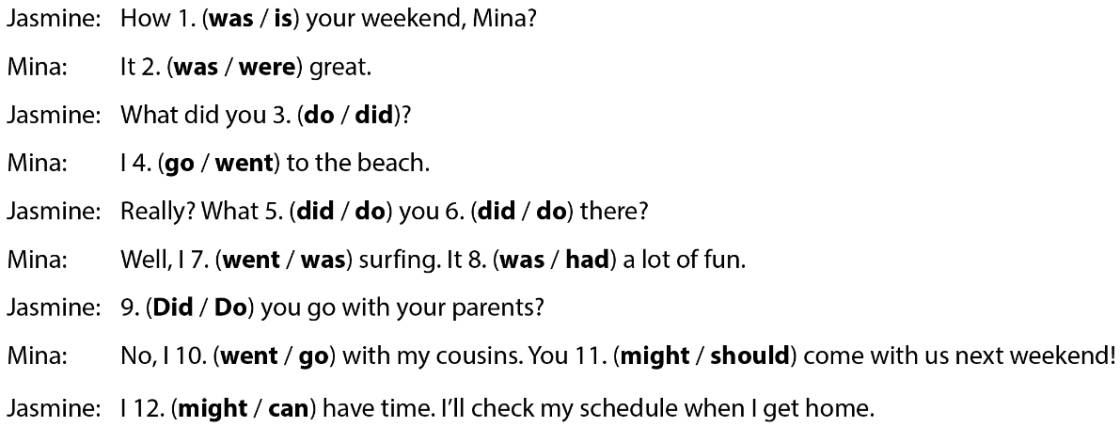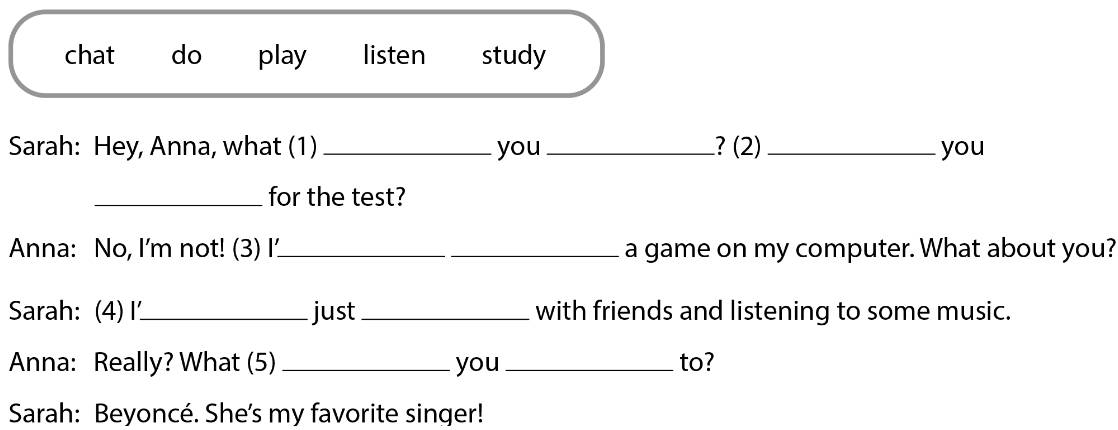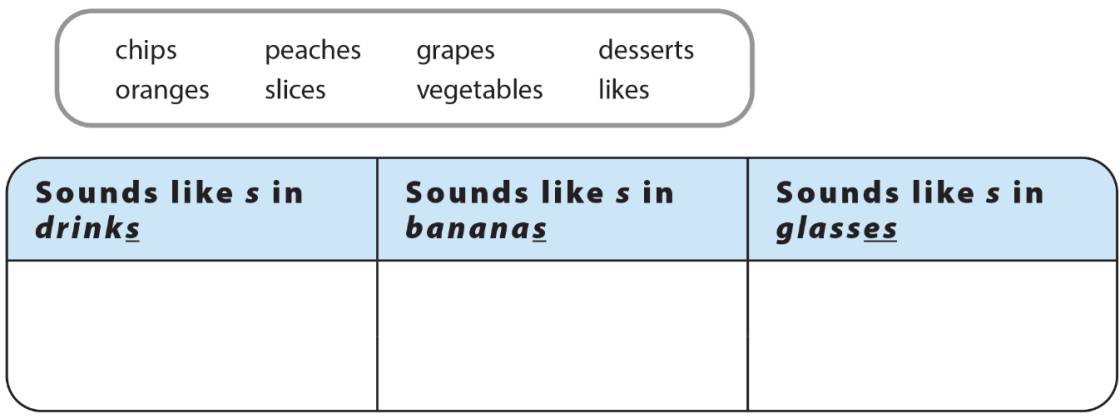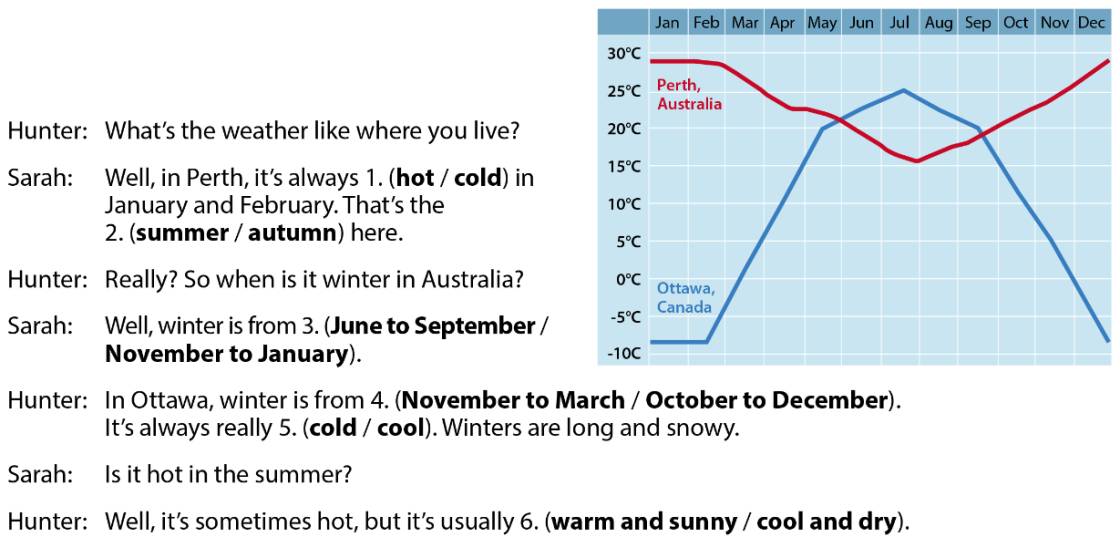Complete the conversation. Circle the correct words. Then listen and check your answers.

Complete the conversation. Use the correct form of the words from the box. Listen and check your answers.

1. are..doing
2. Are…studying..?
3.’m playing
4.’m just chatting
5. ..are…listening..?
Hướng dẫn dịch
Sarah: Hey, Anna, cậu đang làm cái gì đấy. Cậu đang học để ôn tập cho bài kiểm tra à?
Anna: Không, tớ không. Tớ đang chơi trò chơi trên máy tính. Còn cậu thì sao?
Sarah: Tớ chỉ đang nói chuyện với bạn và nghe nhạc thôi
Anna: Thật á? Cậu đang nghe cái gì đấy?
Sarah: Beyonce. Cô ấy là ca sĩ ưa thích của tớ.
B. Complete the chart. Use the words in the box. Then listen and check your answers.

Sounds like s in drinks (Âm s như trong drinks) | Sounds likes s in bananas (Âm s như trong bananas) | Sounds like s in glasses (Âm s như trong glasses) |
- chips - grapes - desserts - likes | - vegetables | - peaches - oranges - slices |
6. Read the Look out! box above and the dialogue below. Circle the correct words to complete the dialogue. Then listen and check.
(Đọc hộp chú ý! ở phía trên và đoạn hội thoại phía dưới. Khoanh tròn các từ đúng để hoàn thành đoạn hội thoại. Sau đó nghe và kiểm tra.)
LOOK OUT! (Chú ý)
In affirmative sentences, much and many often sound very formal. In everyday English, we use a lot of.
(Trong các câu khẳng đinh, much và many nghe có vẻ trang trọng hơn. Trong tiếng Anh hằng ngày, chúng ta dùng a lot of.)
Jack: Look, there's a building with (1) many / some people outside. Turn left just before you get there.
Evie: I can't see (2) any / some people. There isn't (3) many / much light. Hey! What's that noise?
Jack: Nothing. There was (4) any / some rubbish in the road.
Evie: I hate this part of town. There aren't (5) a few/ many nice areas. Let's go north.
Jack: How (6) many / much fuel have we got? Only (7) a few / a little litres.
Evie: Oh no, listen. The police are chasing us now.
Jack: Let me drive. I know (8) a few/ a little tricks.
Mum: Jack, are you doing (9) any / many homework in there?
Jack: Er ... Yes. We're doing (10) a little/ much IT homework.
Evie: Jack! That's not true ...
Jack: Well, we're spending (11) a lot of/ a few time on the computer!
Evie: But we aren't doing (12) some / any work!
1.some | 2. any | 3. much | 4. some | 5. many | 6. much |
7. a few | 8. a few | 9. any | 10. a little | 11. a lot of | 12. any |
Choose the best linking words to complete the sentences. Then listen again and check your answers.
1. Photo A is of a room in a hostel, I think, unless/ whereas the second shows a small flat.
2. There are bunk beds in the room in the hostel, but/ when the other room has got a double bed.
3. While/When photo A shows a rather untidy room, the room in photo B is very tidy.
4. The room in the hostel looks quite cosy. However,/ Whereas the furniture looks a bit old and worn out.
5. I like the idea of sharing with other students, although / despite the lack of privacy.
1. whereas | 2. but | 3. While | 4. However | 5. despite |
(Ảnh A là một căn phòng trong ký túc xá, tôi nghĩ vậy, trong khi ảnh thứ hai chụp một căn hộ nhỏ.)
2 There are bunk beds in the room in the hostel, but the other room has got a double bed.
(Có giường tầng trong phòng của ký túc xá, nhưng phòng còn lại có giường đôi.)
3 While photo A shows a rather untidy room, the room in photo B is very tidy.
(Trong khi ảnh A cho thấy một căn phòng khá bừa bộn thì căn phòng trong ảnh B lại rất ngăn nắp.)
4 The room in the hostel looks quite cosy. However, the furniture looks a bit old and worn out.
(Căn phòng trong ký túc xá trông khá ấm cúng. Tuy nhiên, đồ nội thất trông hơi cũ và sờn.)
5 I like the idea of sharing with other students, despite the lack of privacy.
(Tôi thích ý tưởng chia sẻ với các sinh viên khác, mặc dù thiếu sự riêng tư.)
Look at the weather chart. Complete the conversation. Listen and check your answers. Then practice with a partner.

1 hot
2 summer
3 June to September
4 November to March
5 cold
6 cool and dry
Hướng dẫn dịch
Hunter: Thời tiết nơi bạn sống như thế nào vậy?
Sarah: Ừ, ở Perth thì thời tiết luôn luôn nóng vào tháng một và tháng 2. Thời điểm đó là mùa hè ở đây.
Hunter: Thật á? Vậy khi nào là mùa đông ở Australia?
Sarah: Mùa đông ở Australia là từ tháng 6 đến tháng 9.
Hunter: Ở Ottawa. Mùa đông từ tháng 11 đến tháng 3. Lúc đó trời luôn luôn lạnh. Mùa đông thì dài và có tuyết.
Sarah: Mùa hè trời có nóng không?
Hunter: Nó thỉnh thoảng khá nóng, nhưng nó thường mát và khô.
Exercise 1. Look at pictures 1-9. Then complete the questions with the words in the box. Listen and check your answers.
(Nhìn vào các bức tranh 1-9. Sau đó hoàn thành câu hỏi với các từ trong khung. Nghe và kiểm tra câu trả lời của em.)
art English geography Spanish history PE1 science ICT2 maths PE = Physical Education ICT = Information and Communication Technology 1. Are you good at……………? 2. When’s our next……….exam? 3. Are you a/an……..genius? 4. Is your………..notebook organised? 5. Have we got a/an………..class tomorrow? 6. Do you study other languages, like………..? 7. Have you got……………homework today? 8. Do you think that our textbook is interesting? 9. How many………..teachers are there in the school?
1. PE
2. geography
3. maths
4. science
5. ICT
6. Spanish
7. history
8. English
9. art
1. Are you good at PE?
(Bạn có giỏi môn thể dục không?)
2. When’s our next geography exam?
(Khi nào thì kỳ thi Địa lý tiếp theo của chúng ta?)
3. Are you a maths genius?
(Bạn có phải là một thiên tài toán học không?)
4. Is your science notebook organised?
(Sổ ghi chép khoa học của bạn có được sắp xếp không?)
5. Have we got an ICT class tomorrow?
(Ngày mai chúng ta có tiết học Công nghệ thông tin và truyền thông không?)
6. Do you study other languages, like Spanish?
(Bạn có học các ngôn ngữ khác, như tiếng Tây Ban Nha không?)
7. Have you got history homework today?
(Hôm nay bạn có bài tập Lịch sử không?)
8. Do you think that our English textbook is interesting?
(Bạn có nghĩ sách giáo khoa tiếng Anh của chúng ta thú vị không?)
9. How many art teachers are there in the school?
(Có bao nhiêu giáo viên mỹ thuật trong trường?)
Complete the conversation. Then listen and check your answers.

1. How much is/ It’s
2. How much is/ It’s
3. How much is/ It’s/ It’s
4. How much are/ They’re
Hướng dẫn dịch
1.
A: Cái ví này bao nhiêu tiền vậy?
B: Nó có giá $12
2.
A: Cái đồng hồ kia bao nhiêu tiền vậy?
B: Nó có giá $50
3.
A: Cái mũ này bao nhiêu tiền vậy?
B: Nó khá là rẻ. Nó có giá $10
4.
A: Những quyển sách kia bao nhiêu tiền vậy?
B: Chúng có giá $12
2. Complete the compound nouns in the fact file with the words below. Use a dictionary to help you. Then listen and check your answers.
(Hoàn thành các danh từ ghép trong hồ sơ dữ liệu với các từ bên dươi. Sử dụng từ điển để giúp bạn. Sau đó nghe và kiểm tra bài làm.)
GLOBAL WARMING
Fact file
> The Earth is heating up. The average (1) _____ temperature is 0.75°C higher now than it was 100 years ago.
> When we burn (2) _____ fuels, they give off (3) _____ gases like carbon dioxide (CO2). This causes (4) _____ warming.
> We have cut down over 50% of the Earth's (5) _____ forests in the last 60 years. These are important because they remove CO2 from the atmosphere and add oxygen. They are also home to over half of the world's plant and animal species.
> Some scientists believe that by 2050, about 35% of all plant and animal species could die out because of (6) _____ change.
> (7) _____levels are rising and the polar (8) _____ caps are melting.
> Scientists say that fossil fuels like coal and gas may run out by the year 3000. So we need to develop alternatives, such as (9) _____ energy and nuclear energy.
1. surface
2. fossil
3. greenhouse
4. global
5. rain
6. climate
7. sea
8. ice
9. renewable
Hướng dẫn dịch:
SỰ NÓNG LÊN TOÀN CẦU
Hồ sơ dữ kiện
Trái đất đang nóng lên. Nhiệt độ bề mặt trung bình hiện nay cao hơn 0,75 ° C so với 100 năm trước.
Khi chúng ta đốt nhiên liệu hóa thạch, chúng thải ra khí nhà kính như carbon dioxide (CO2). Điều này gây ra hiện tượng ấm lên toàn cầu.
Chúng ta đã chặt phá hơn 50% rừng mưa trên Trái đất trong 60 năm qua. Những điều này rất quan trọng vì chúng loại bỏ CO2 khỏi khí quyển và bổ sung oxy. Chúng cũng là nơi sinh sống của hơn một nửa số loài động thực vật trên thế giới.
Một số nhà khoa học tin rằng đến năm 2050, khoảng 35% các loài động thực vật có thể chết vì biến đổi khí hậu.
Mực nước biển đang dâng cao và các chỏm băng ở hai cực đang tan chảy.
Các nhà khoa học nói rằng nhiên liệu hóa thạch như than và khí đốt có thể cạn kiệt vào năm 3000. Vì vậy, chúng ta cần phát triển các giải pháp thay thế, chẳng hạn như năng lượng tái tạo và năng lượng hạt nhân.
Complete the chart. Then listen and check your answers.

B:
Sounds like /u:/ in movie: two
Sounds like /əʊ/ in go: no,oh,open
Sounds like /ʌ/ in front: tony, london, come